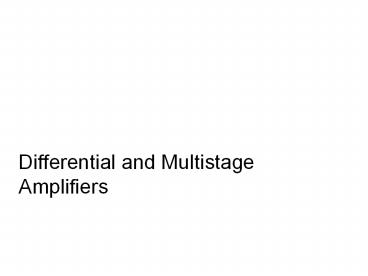Lecture I: Introduction to pattern recognition PowerPoint PPT Presentation
Title: Lecture I: Introduction to pattern recognition
1
Differential and Multistage Amplifiers
2
Differential Amplifier
- Why Differential?
- Much less sensitive to noise and interference
- To bias and couple amplifier without the need of
capacitors - Take advantage of the availability of large
number of transistors at relatively low cost in IC
-
-
3
The MOS Differential Pair
- Operation with a Common-Mode Input Voltage
4
Small-Signal Operation of the MOS Differential
Pair
- Differential Gain
single-ended output v.s. differential output
5
Small-Signal Operation of the MOS Differential
Pair
- Differential Gain (cont.)
Neglect ro
Virtual Ground, NO capacitor!
6
Small-Signal Operation of the MOS Differential
Pair
- Differential Gain Effect of ro
7
Small-Signal Operation of the MOS Differential
Pair
- Common-mode gain and common-mode rejection ration
Neglect ro
For single-end output
For differential output
8
Small-Signal Operation of the MOS Differential
Pair
- Common-mode gain and common-mode rejection
ration - Effect of RD Mismatch on CMRR
9
Small-Signal Operation of the MOS Differential
Pair
- Common-mode gain and common-mode rejection ration
- Effect of gm Mismatch on CMRR
neglecting ro
10
Frequency Response of the Differential Amplifier
- Analysis of the Resistively Loaded MOS Amplifier
Differential half-circuit Common Source
Amplifier
RSS Output Resistance of QS CSS Cdbs, Cgds,
Csb1, Csb2
11
Frequency Response of the Differential Amplifier
Analysis of the Resistively Loaded MOS Amplifier
(cont.)
12
Frequency Response of the Differential Amplifier
Analysis of the Resistively Loaded MOS Amplifier
(cont.)
Figure 7.37 Variation of (a) common-mode gain,
(b) differential gain, and (c) common-mode
rejection ratio with frequency.
13
Frequency Response of the Differential Amplifier
Analysis of the Active-Loaded MOS Amplifier
14
Frequency Response of the Differential Amplifier
Analysis of the Active-Loaded MOS Amplifier
(cont.)
Figure 7.39 The overall transconductance Gm as a
function of frequency.
15
Homework
7.1 (a, b), 7.2, 7.7, 7.9, 7.12, 7.14, 7.15
PowerShow.com is a leading presentation sharing website. It has millions of presentations already uploaded and available with 1,000s more being uploaded by its users every day. Whatever your area of interest, here you’ll be able to find and view presentations you’ll love and possibly download. And, best of all, it is completely free and easy to use.
You might even have a presentation you’d like to share with others. If so, just upload it to PowerShow.com. We’ll convert it to an HTML5 slideshow that includes all the media types you’ve already added: audio, video, music, pictures, animations and transition effects. Then you can share it with your target audience as well as PowerShow.com’s millions of monthly visitors. And, again, it’s all free.
About the Developers
PowerShow.com is brought to you by CrystalGraphics, the award-winning developer and market-leading publisher of rich-media enhancement products for presentations. Our product offerings include millions of PowerPoint templates, diagrams, animated 3D characters and more.

